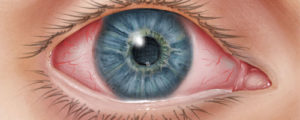
Conjunctivitis (pink eye) is a common condition that causes redness in the conjunctiva, which lines the inside of the eyelid and the white part of the eye. There are many causes of conjunctivitis, most of which are easily treated. However, in severe cases, it may be necessary to seek medical treatment. If you are experiencing severe symptoms, see your eye care provider as soon as possible. For more information on conjunctivitis, continue reading below.
Table of Contents:
- What is conjunctivitis?
- What are the different types of conjunctivitis?
- How is conjunctivitis diagnosed?
- How is conjunctivitis treated?
- What is the difference between conjunctivitis and pink eye?
- How long is pinkeye contagious?
For appointments at Louisiana Eye & Laser, you can call, schedule online or stop by any of our 14 convenient locations.
What is conjunctivitis?
Conjunctivitis, more commonly known as pink eye, is an infection of the conjunctiva. The conjunctiva is a clear mucous membrane that covers the inside of the eyelid and the sclera (white of the eye). When the conjunctiva is infected, it may become red and/or swollen, causing pain or discomfort.

What are the different types of conjunctivitis?
There are three main types of conjunctivitis:
- Viral conjunctivitis can be caused by many different viruses, such as those that cause the common cold. Viral conjunctivitis may be the result of close contact with someone who has pink eye or even someone who is coughing or sneezing. Like the common cold, there is no cure for viral conjunctivitis; it must simply run its course. Viral conjunctivitis is often highly contagious and can cause widespread outbreaks if not treated appropriately. It can spread from one eye to the other as well.
- Bacterial conjunctivitis can be caused by a few different types of bacteria, including some that cause sexually transmitted infections. Bacterial conjunctivitis can be caused by insects, person-to-person contact, poor hygiene and even contaminated personal care products (i.e. lotion or make up). Bacterial conjunctivitis can be treated with antibiotics.
- Allergic conjunctivitis is caused by allergies. Unlike viral and bacterial conjunctivitis, it cannot be spread from one person to another. Allergic conjunctivitis occurs when contact with an irritant (such as pollen) triggers an allergic reaction. It is most common amongst those who normally suffer from seasonal allergies.

How is conjunctivitis diagnosed?
Doctors typically diagnose and treat conjunctivitis based on patient history, other symptoms and an examination of the eye. While all forms of conjunctivitis involve redness and swelling of the eye, there are other factors that vary between viral, bacterial and allergic conjunctivitis. If there is discharge, viral conjunctivitis has a watery discharge while bacterial conjunctivitis has thick discharge. Allergic conjunctivitis is often accompanied by intense itchiness.
Your doctor may also test your vision to make sure that the infection has not negatively impacted your visual acuity. If doctors are unable to diagnose based on an initial eye exam, patient history and other symptoms, a more extensive exam may be required. Taking samples from the eye to be tested in a lab may be necessary if a patient is unresponsive to treatments.
How is conjunctivitis treated?
Treatments vary depending on the underlying cause. For viral conjunctivitis, there are no cures. Antiviral medication may be prescribed to help in more severe cases. Antibiotic eye drops or ointments can help treat bacterial infections. Allergic conjunctivitis is most often improved by avoiding the irritant and the environment in which it is found. In many cases, the conjunctivitis will clear up on its own in a matter of days or weeks. Cool compresses, artificial tears and ceasing to wear contacts can help to increase comfort.
What is the difference between conjunctivitis and pinkeye?
Conjunctivitis is an ocular disease that can be caused by viruses, bacteria, or allergens. Millions of people get pinkeye every year around the world. This disease is extremely common and can be easily spread. The most easily identifiable symptom of conjunctivitis is the inflammation of the conjunctiva which is the clear tissue over the white part of the eye. The inflammation appears red or pink which is why the common name for conjunctivitis is pinkeye. Pinkeye and conjunctivitis are synonymous and describe the same condition in the eye. If you hear somebody use the term conjunctivitis, they are referring to pinkeye.
How long is pinkeye contagious?
A common question that our eye care professionals get asked by patients is “how long is pinkeye contagious?” Unfortunately there is not a predetermined time frame where pink eye is contagious. Pinkeye can be contagious as long as symptoms are present. The virus/ bacteria can take anywhere from three to seven days to run its course and no longer be contagious. The good news is that pinkeye is no more contagious than the common cold. As long as you practice good hygiene and wash your hands frequently, your immediate family should not be affected. Visit a doctor to determine how severe your pinkeye is and how you should go about minimizing the amount of time that you are contagious.

Visit Louisiana Eye & Laser
In most cases, pink eye will go away on its own. However, if you are experiencing symptoms beyond the normal, mild symptoms associated with conjunctivitis, come see the experts at Louisiana Eye & Laser. After more than 40 years in the eye care industry, our trained and professional staff have seen it all. Simply call, go online or stop by one of our 14 offices to schedule an eye exam.




